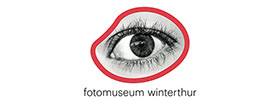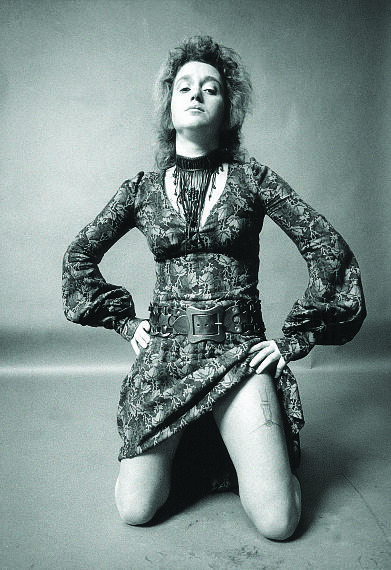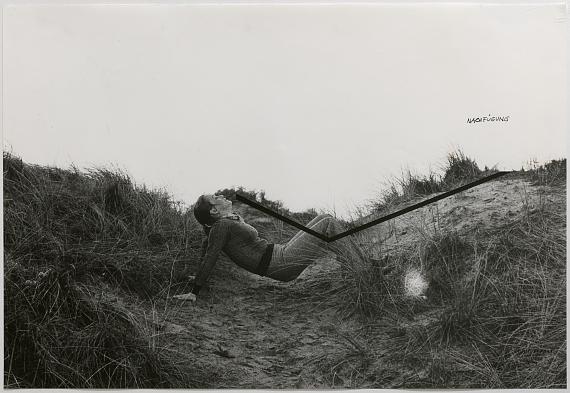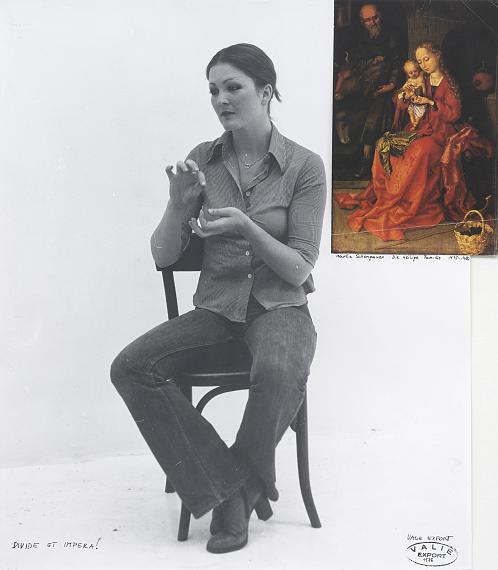
self-portrait, 1970
ALBERTINA, Wien – The ESSL Collection
© VALIE EXPORT, 2022, ProLitteris, Zurich
photo: Gertraud Wolfschwenger
VALIE EXPORT »
The Photographs / Die Fotografien
Exhibition: 25 Feb – 29 May 2023
Fri 24 Feb 18:00 - 21:00

Fotomuseum Winterthur
Grüzenstr. 44+45
8400 Winterthur
+41 (0)52-2341060
info@fotomuseum.ch
www.fotomuseum.ch
Tue, Thu, Fri 11-17; Wed 11-20; Sat-Sun 11-18

Elisabeth Lebovici), in cooperation with Peter Weibel, 1968
courtesy Galerie Thaddaeus Ropac and the artist
© VALIE EXPORT, 2022 ProLitteris, Zurich
photo: Joseph Tandl
VALIE EXPORT
"The Photographs"
Exhibition: 2 February – 29 May 2023
Opening: Friday, 24 February, 6pm
VALIE EXPORT – The Photographs is the first exhibition to focus on the photographic oeuvre of the artist VALIE EXPORT (b. 1940), whose at times provocative performances and experimental installations have been a source of controversy. The show examines EXPORT’s use of photography as a critical exploration of processes of depiction and representation. At the interface of film, video art, drawing and body art the photographs offer a new perspective on her creative oeuvre.
VALIE EXPORT’s multimedia work eludes any simplistic categorisation or definition. As a pioneer of performance art, installation art and video art, EXPORT has consistently broken through the boundaries separating media genres, while using her own body as an artistic medium. Photography has always played a key role in her practice – be it for documentary
or experimental purposes, as an element in multimedia installations or as art in its own right.
EXPORT has had a constant awareness of the importance of visually recording her performances. Back in 1968 two of her best-known performances, TAPP und TASTKINO and the action Aus der Mappe der Hundigkeit, were attended by photographers (and filmmakers). For the performance TAPP und TASTKINO, a request was put out by megaphone asking spectators and passers-by to touch EXPORT’s breasts, which were covered by a box inspired by a cinema auditorium with a curtain that the artist wore like a garment. Participants had to maintain eye contact with EXPORT for a defined period of time while touching her, with the artist thereby reversing the voyeuristic male gaze, a typical feature of cinema. For Aus der Mappe der Hundigkeit, EXPORT took artist Peter Weibel through the centre of Vienna on a lead, with him crawling on all fours, provocatively drawing attention to the prevailing gender relations and power dynamics by reversing them.
Photography was not merely used to make a complete document of EXPORT’s work. Rather, action and photography entered into a dialogue, creating a mutual dependency between them: on the one hand, actions were recorded (and ultimately communicated
too) by means of photography; on the other, by virtue of their production, publication and reception – especially of key moments such as the interaction between artist and participants in TAPP und TASTKINO and their switch of perspective – EXPORT’s action photos acquired a status that was independent of the performances.
EXPORT’s focus on the critical examination of mechanisms of representation dates right back to the start of her career, when she began dealing with the different characteristics of the photographic image and imaging media, questioning the way they worked and subjecting photography to conceptual analysis by lifting the lid on the conditions governing the technical processes of image-making. Deconstructing the photographic gaze and its implicit power structures were of key importance here.
For EXPORT, the critical analysis of systems of representation invariably went hand in hand, in the context of both media and society, with a questioning of the male gaze directed at a body viewed as female. Making reference to her own body, she repeatedly probed the role of the woman, the artist and the subject in patriarchal sociopolitical structures. In 1970, for example, EXPORT had a garter tattooed on her thigh for Body Sign Action to give visible expression to the woman’s status as a sexual object and projection surface for male fantasies. Besides capturing the act of being tattooed, EXPORT also took photographs of the tattoo itself. The work expresses the pain involved – quite literally – in having patriarchal norms inscribed on a body that is seen as female. With her series Body Configurations (1972–1982), EXPORT investigates the relationships between the subject and power-political structures through body postures too. She explicitly couches her critique of the processes of depiction and representation in feminist terms: her work centres on the relationship between subject and space, body and gaze, femaleness and representation.
The exhibition VALIE EXPORT – The Photographs, which was devised in close collaboration with the artist, focuses on the impact that photography has had on her creative output. However, following the logic of EXPORT’s work, the exhibition not only presents photographs but also juxtaposes different media and works created between 1968 and
2007.
The exhibition is curated by Walter Moser and produced in cooperation with the Albertina, Vienna.
VALIE EXPORT was born in 1940 in Linz, Austria, and now lives and works in Vienna. She is one of the pioneers of performance art and conceptual art. In 1967, in what was a radical gesture at the time, she gave up her father’s and her ex-husband’s names and laid claim to a new identity, VALIE EXPORT. Her works have been shown worldwide as part of numerous solo and group exhibitions. EXPORT has taught at various international institutions and was
a professor for performance and multimedia at the Academy of Media Arts Cologne from 1995 to 2005. The VALIE EXPORT Center Linz was established through the acquisition of the artist’s estate in 2015, thus laying the foundations for an international research centre to foster artistic and academic engagement with media art and performance art.

ALBERTINA, Wien – The ESSL Collection
© VALIE EXPORT
photo: Gertraud Wolfschwenger
VALIE EXPORT
"Die Fotografien"
Ausstellung: 25. Februar bis 29. Mai 2023
Eröffnung: Freitag, 24. Februar, 18 Uhr
Die Ausstellung VALIE EXPORT – Die Fotografien stellt erstmals das fotografische OEuvre der Künstlerin VALIE EXPORT (*1940), die insbesondere mit ihren teils provozierenden Performances und experimentellen Installationen für Aufsehen sorgte, in den Mittelpunkt. Dabei wird unter anderem EXPORTs Einsatz von Fotografie als kritische Auseinandersetzung mit Abbildungs- und Repräsentationsprozessen untersucht. An der Schnittstelle von Film, Videokunst, Zeichnung und Body-Art erlauben die gezeigten Fotografien eine neue Perspektive auf das Schaffen von EXPORT.
Das multimediale Werk VALIE EXPORTs entzieht sich vereinfachenden Kategorisierungen und Festschreibungen. Als Pionierin der Performance-, Installations- und Videokunst durchbricht die Künstlerin seit jeher die Grenzen zwischen medialen Genres und setzt auch ihren eigenen Körper als künstlerisches Medium ein. Die Fotografie spielt in ihrer Praxis von
Anbeginn eine zentrale Rolle – ob zu dokumentarischen Zwecken, als Experiment, als Bestandteil multimedialer Installationen oder als eigenständiges Werk.
EXPORT war sich der Bedeutung der visuellen Aufzeichnung ihrer Performances stets bewusst. Bereits 1968, bei zwei ihrer bekanntesten Performances, dem TAPP und TASTKINO und der Aktion Aus der Mappe der Hundigkeit waren Fotograf_innen (und Filmemacher_innen) zugegen. Für die Performance TAPP und TASTKINO wurden Zuschauer und Passanten über ein Megafon aufgefordert, EXPORTs Brüste zu berühren, die von einem als Kinosaal dienenden Kasten mit Vorhang, den die Künstlerin wie ein Kleidungsstück trug, verdeckt waren. Die Teilnehmenden mussten beim Akt der Berührung mit EXPORT für eine genau definierte Zeitdauer Augenkontakt halten, wodurch die Künstlerin den für das Kino typischen Voyeurismus des männlichen Blicks umkehrte. Für Aus der Mappe der Hundigkeit führte EXPORT den auf allen Vieren kriechenden Künstler Peter Weibel an einer Hundeleine durch die Innenstadt Wiens, wodurch sie auf provokante Art und Weise durch deren Umkehrung auf vorherrschende Geschlechterverhältnisse und Machtdynamiken aufmerksam machte.
Die Fotografie diente nicht bloss der Aufzeichnung von EXPORTs Aktionen. Viel eher traten Aktion und Fotografie in einen Dialog und somit eine wechselseitige Abhängigkeit; einerseits wurden mithilfe der Fotografie Aktionen festgehalten (und schliesslich auch vermittelt), andererseits erreichten EXPORTs Aktionsfotos durch ihre Produktion, Publikation und Rezeption – insbesondere von Schlüsselmomenten wie der Interaktion und dem Blickaustausch zwischen Künstlerin und Teilnehmenden beim TAPP und TASTKINO – einen von den Performances unabhängigen Status.
EXPORT widmete sich schon zu Beginn ihrer Karriere der kritischen Untersuchung von Abbildungsmechanismen: Sie verhandelte die unterschiedlichen Charakteristika des fotografischen Bilds und bildgebender Medien, hinterfragte deren Funktionsweisen und unterzog die Fotografie einer konzeptuellen Analyse, indem sie die Bedingungen technischer Abbildungsprozesse offenlegte. Eine zentrale Rolle spielte dabei die Dekonstruktion des fotografischen Blicks und seiner implizierten Machtstrukturen. Die kritische Analyse von Repräsentationssystemen ging für EXPORT unweigerlich mit der Darstellung des weiblich gelesenen Körpers einher. Unter Bezugnahme auf den eigenen Körper hat sie die Rolle der Frau, der Künstlerin und des Subjekts innerhalb von patriarchalen gesellschaftspolitischen Strukturen immer wieder untersucht.
Im Jahr 1970 liess sich EXPORT für Body Sign Action beispielswiese ein Strumpfband auf den Oberschenkel tätowieren, um den Status der Frau als Sexualobjekt und Projektionsfläche männlicher Fantasien sichtbar zu machen. Das Werk bringt zum Ausdruck, wie sich patriarchale Normen dem weiblich gelesenen Körper – buchstäblich – auf schmerzhafte Weise einschreiben. Auch mit ihrer Werkgruppe der Körperkonfigurationen (1972–1982) untersucht EXPORT über Körperhaltungen die Beziehungen zwischen Subjekt und machtpolitischen Strukturen. Sie formuliert ihre Kritik an Abbildungs- und Repräsentationsprozessen explizit als feministische Kritik: Im Zentrum ihres Werks steht das Verhältnis von Subjekt und Raum, Körper und Blick, Weiblichkeit und Repräsentation.
Die Ausstellung VALIE EXPORT – Die Fotografien, welche in enger Zusammenarbeit mit der Künstlerin entstanden ist, legt den Fokus auf die Relevanz der Fotografie für ihr Schaffen. Der Logik von EXPORTs Werk folgend, präsentiert die Ausstellung dennoch nicht nur Fotografien, sondern stellt unterschiedliche Medien und Werke, die zwischen 1968 und
2007 entstanden sind, einander gegenüber.
Die Ausstellung wird kuratiert von Walter Moser und ist eine Kooperation mit der Albertina, Wien.
VALIE EXPORT wurde 1940 in Linz, Österreich, geboren und lebt und arbeitet heute in Wien. Sie zählt zu den Pionier_innen der Performance- und Konzeptkunst. 1967 legte sie mit dem Namen VALIE EXPORT in einer zu dieser Zeit radikalen Geste sowohl den Namen ihres Vaters als auch den ihres Exmannes ab, um eine neue Identität für sich zu beanspruchen. Ihre Werke wurden weltweit im Rahmen zahlreicher Einzel- und Gruppenausstellungen gezeigt. EXPORT lehrte an unterschiedlichen internationalen Institutionen und war von 1995 bis 2005 als Professorin für Multimedia-Performance an der Kunsthochschule für Medien in Köln tätig. Mit dem Erwerb des Vorlasses der Künstlerin wurde 2015 das VALIE
EXPORT Center Linz gegründet und damit der Grundstein für ein internationales Forschungszentrum gelegt, welches die künstlerische und wissenschaftliche Auseinandersetzung mit Medien- und Performancekunst fördert.

courtesy Galerie Thaddaeus Ropac and the artist
© VALIE EXPORT, 2022, ProLitteris, Zurich
photo: Eric Timmermann

courtesy Galerie Thaddaeus Ropac and the artist
© VALIE EXPORT, 2022, ProLitteris, Zurich